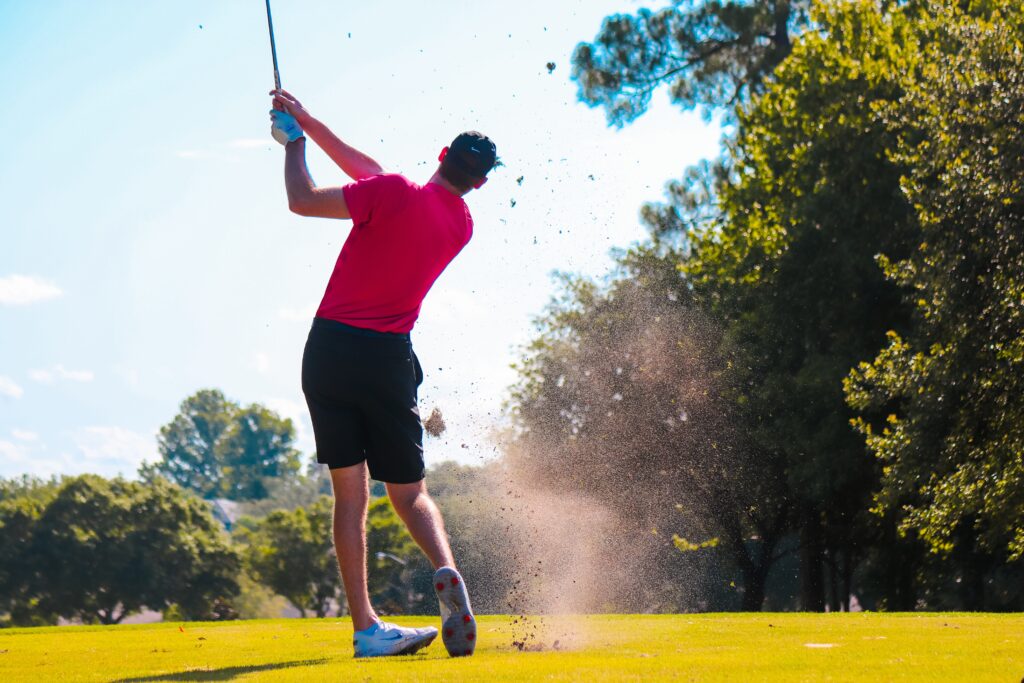The golf swing is a symphony of coordinated movements, requiring precise timing, technique, and athleticism. While golfers often focus on their grip, posture, and swing mechanics, one crucial yet often overlooked aspect is the role of hip mobility. The hips serve as the cornerstone of a powerful and efficient swing, influencing swing mechanics and overall performance.
In this blog post, we will explore the importance of hip mobility in your golf swing and shed light on how restricted hip mobility can significantly impact your swing mechanics and overall performance on the course.
In This Article:
Understanding Hip Mobility and Golf Swing Mechanics
To truly appreciate the importance of hip mobility in the golf swing, it’s essential to understand the biomechanics behind this complex movement and the integral role that the hips play in executing an effective swing.
The golf swing can be divided into several key phases: the setup, backswing, downswing, impact, and follow-through. Each phase requires a harmonious coordination of movements to generate power, accuracy, and consistency.
During the setup, as you address the ball, your hips play a crucial role in establishing a stable foundation. Proper hip positioning and alignment contribute to a solid base and help maintain balance throughout the swing. This stability is essential for maintaining control and generating power efficiently.
As you initiate the backswing, the hips serve as the rotational engine of the swing. With a proper weight shift and rotation of the pelvis, the hips initiate the coiling of the upper body against the lower body. This coiling motion creates potential energy, storing it within the muscles and connective tissues, ready to be unleashed during the downswing.
The downswing is where the transfer of power from the lower body to the upper body occurs. The hips initiate the rotation and begin to transfer the stored energy from the backswing to the rest of the body. This transfer of energy allows for a sequential “uncoiling” of the body, resulting in the generation of clubhead speed.
At impact, the hips continue to rotate, helping to drive the clubhead through the ball. The correct sequencing of the hip rotation ensures that the transfer of power is maximized, translating into a powerful and accurate strike.
Finally, during the follow-through, the hips play a role in maintaining balance and controlling the deceleration of the swing. A smooth and controlled hip rotation through the finish contributes to a balanced and controlled ending position.
The role of the hips in the golf swing cannot be overstated. Efficient hip movement allows for proper weight transfer, optimal rotation, and the generation of clubhead speed. It contributes to the sequence and timing of the swing, enabling a more consistent and powerful strike.
Hip Movement
The hip joint is a ball-and-socket joint that allows for a wide range of motions. The primary movements of the hip joint include:
- Flexion: This movement involves bending the hip joint, bringing the femur (thigh bone) closer to the front of the body. It is facilitated by the contraction of the hip flexor muscles, including the iliopsoas, rectus femoris, and sartorius.
- Extension: Extension is the opposite movement of flexion and involves straightening or extending the hip joint. It is primarily carried out by the contraction of the hip extensor muscles, such as the gluteus maximus and hamstrings.
- Abduction: Abduction is the movement of the femur away from the midline of the body. It is achieved by the contraction of the hip abductor muscles, including the gluteus medius and gluteus minimus.
- Adduction: Adduction refers to moving the femur back towards the midline of the body. This motion is facilitated by the contraction of the hip adductor muscles, such as the adductor longus, adductor brevis, and adductor magnus.
- Internal Rotation: Internal rotation involves rotating the femur inward towards the midline of the body. This motion is accomplished by the muscles of internal rotation, including the gluteus medius, gluteus minimus, and tensor fasciae latae.
- External Rotation: External rotation is the rotation of the femur outward away from the midline of the body. It is carried out by the muscles responsible for external rotation, such as the piriformis, gemellus muscles, and obturator externus.
Understanding the specific anatomical structures involved in each range of motion can provide a clearer picture of how the hip joint moves and which muscles contribute to these movements. Proper flexibility, strength, and coordination of these muscles are essential for optimal hip mobility and functional activities such as the golf swing.
Ideal Ranges of Motion
| Range of Motion | Recommended Degrees |
|---|---|
| Flexion | 110-120 |
| Extension | 10-15 |
| Abduction | 40-45 |
| Adduction | 20-30 |
| Internal Rotation | 30-40 |
| External Rotation | 40-60 |
Common Issues and Limitations Golfers Face With Hip Mobility
When it comes to hip mobility, golfers can face several common issues and limitations that can impact their swing mechanics and overall performance. Understanding these challenges can help golfers identify areas for improvement and seek appropriate strategies to enhance their hip mobility. Here are some of the common issues and limitations golfers face with hip mobility:
Restricted Hip Rotation ️♂️
Limited hip rotation is a prevalent issue among golfers. Insufficient rotation in the hips can lead to compensations in other areas of the body, such as excessive spinal rotation or over-reliance on the upper body for generating power. Restricted hip rotation can result from factors like tight hip muscles, joint stiffness, or inadequate flexibility in the surrounding structures.
Inefficient Weight Transfer ↔️
Hip mobility plays a crucial role in facilitating a smooth and efficient weight transfer during the golf swing. Restricted hip mobility can hinder the ability to shift weight effectively from the trail leg to the lead leg, leading to balance issues, inconsistent strikes, and decreased power generation. Insufficient hip mobility can disrupt the sequencing and timing of movements necessary for optimal weight transfer.
Sway and Slide
Limited hip mobility can contribute to sway and slide, which are excessive lateral movements during the swing. These compensatory movements often occur when golfers lack the ability to rotate the hips properly. Sway refers to a lateral shift away from the target, while slide involves an excessive movement towards the target. Both can result in swing faults, loss of power, and compromised stability.
Low Back Pain ⚡️
Restricted hip mobility can place additional stress on the lower back, leading to discomfort and potential injury. When the hips lack the necessary range of motion, the lower back may compensate by rotating excessively, extending excessively, or being subjected to excessive twisting forces. Over time, these compensations can contribute to lower back pain and decreased performance.
Benefits of Improved Hip Mobility in Golf
Increased hip mobility plays a significant role in enhancing the power and distance of your golf swing. By improving hip mobility, you can unlock greater potential for generating clubhead speed, maximizing energy transfer, and achieving optimal swing mechanics. Here are some key ways in which increased hip mobility can enhance the power and distance of your swing:
| Benefits of Increased Hip Mobility |
|---|
| Enhanced Power and Distance: Increased hip mobility allows for greater rotation and coil, resulting in more stored potential energy and generating increased power and distance in the golf swing. |
| Improved Energy Transfer: Proper hip mobility enables efficient transfer of energy from the lower body to the upper body, maximizing power transfer to the clubhead. |
| Optimal Sequencing: Enhanced hip mobility facilitates proper sequencing of movements, enabling a smooth weight shift and rotation that effectively transfers power from the lower body to the clubhead. |
| Improved Stability and Balance: Proper hip mobility promotes better stability and balance, providing a solid foundation during the swing, resulting in more consistent and accurate strikes. |
How Proper Hip Mobility Can Help Prevent Swing Faults and Injuries
Proper hip mobility plays a crucial role in preventing swing faults and injuries in golf. When golfers have adequate hip mobility, they can execute the swing with optimal mechanics, maintain stability, and reduce stress on other areas of the body. Here are some ways in which proper hip mobility can help prevent swing faults and injuries:
Improved Swing Mechanics
Adequate hip mobility allows for proper sequencing and coordination of the swing. It enables golfers to initiate the swing with the lower body, transfer energy smoothly from the hips to the upper body, and achieve the desired swing plane and club path. Without proper hip mobility, compensations may occur, leading to swing faults such as overuse of the upper body, early extension, or loss of posture.
Enhanced Balance and Stability
Hip mobility contributes to overall stability and balance throughout the swing. With good hip mobility, golfers can maintain a stable base and prevent excessive lateral movements or swaying. This stability allows for a more controlled swing, reduces the risk of losing balance during the swing, and helps maintain proper posture and alignment.
Reduced Strain on Other Body Regions
When the hips lack mobility, other areas of the body may compensate to compensate for the limited range of motion. For example, restricted hip mobility can lead to excessive spinal rotation, increased stress on the lower back, or overuse of the arms and shoulders. These compensations can increase the risk of injuries, such as lower back pain, muscle strains, or tendonitis.
Injury Prevention
Proper hip mobility can help prevent injuries in both the hips and surrounding areas. By maintaining adequate range of motion in the hips, golfers can reduce the risk of muscle imbalances, strain on the hip joint, and overuse injuries. It allows for smoother and more natural movements throughout the swing, minimizing the likelihood of sudden forces or awkward positions that may cause injury.
Enhanced Power Transfer
Hip mobility is closely linked to power generation in the golf swing. With good hip mobility, golfers can efficiently transfer energy from the lower body to the upper body and ultimately to the clubhead. This optimal power transfer reduces the likelihood of compensatory movements or swing faults that can place stress on other body parts and increase the risk of injuries.
Summary:
Proper hip mobility in golf is essential for preventing swing faults and injuries. By maintaining good hip mobility, golfers can optimize their swing mechanics, enhance balance and stability, reduce strain on other body regions, prevent injuries, and improve power transfer.
Adequate hip mobility allows for proper sequencing and coordination of the swing, reducing the risk of compensations and swing faults. It promotes a stable base and proper posture, minimizing the likelihood of losing balance during the swing. By preventing compensatory movements, proper hip mobility reduces stress on other body regions such as the lower back, arms, and shoulders. It helps prevent muscle imbalances, strain, and overuse injuries during the swing.
Moreover, optimal hip mobility enables efficient energy transfer from the lower body to the upper body, reducing the risk of compensatory movements and enhancing power generation.
By prioritizing hip mobility through targeted exercises and mobility drills, golfers can prevent swing faults and injuries, leading to a more enjoyable and injury-free golfing experience.









